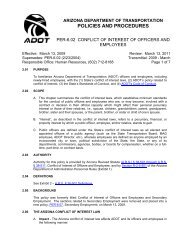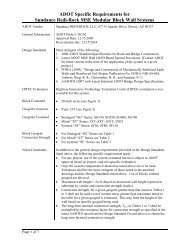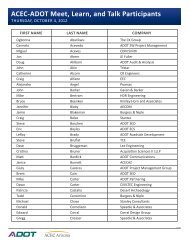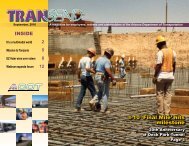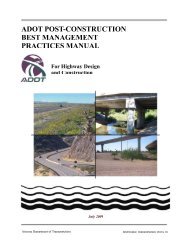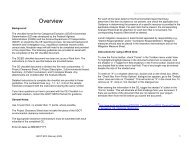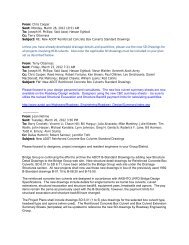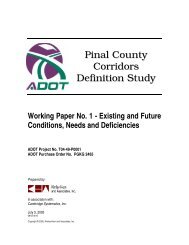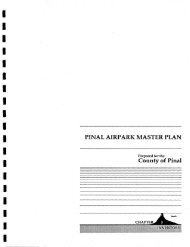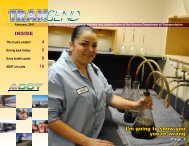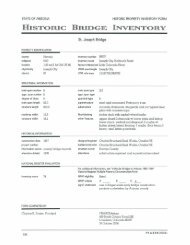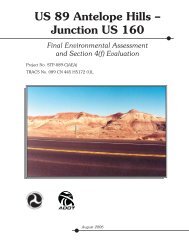I-10 Twin Peaks Traffic Interchange, Environmental Assessment
I-10 Twin Peaks Traffic Interchange, Environmental Assessment
I-10 Twin Peaks Traffic Interchange, Environmental Assessment
You also want an ePaper? Increase the reach of your titles
YUMPU automatically turns print PDFs into web optimized ePapers that Google loves.
Affected Environment and <strong>Environmental</strong> Impacts October 2005<br />
As a result, a modified design alternative was developed and analyzed. This<br />
modified design consisted of longer bridges with shorter embankments, and an<br />
accompanying widening of the low flow channel of the Santa Cruz River. The<br />
proposed design (the preferred alternative) consisted of proposed 750-foot long<br />
twin bridges over the low flow channel and a widening of the low flow channel to<br />
a 6<strong>10</strong>-foot top width at the bridge crossing. The modeled channel widening<br />
transitioned back to the existing 400-foot width over a distance of approximately<br />
1,500 feet upstream and downstream of the bridge crossing. The modeled<br />
widening was assumed to occur entirely on the west side of the existing low flow<br />
channel because the existing bank protection on the west side of the channel<br />
exhibits undercutting and is in need of repairs. This alternative would not increase<br />
flood elevations by more than 0.1 foot; therefore, this alternative was advanced for<br />
preliminary design and environmental investigation.<br />
The alternatives and analyses within the floodplain were developed in consultation<br />
with several local, state, and federal water resource and floodplain management<br />
agencies. Meetings or telephone conversations with ADOT and the U.S. Army<br />
Corps of Engineers (Corps) were held to obtain current information on<br />
development and proposed actions in the affected watersheds. These discussions<br />
helped also guide the preliminary alternatives design. The resulting analytical<br />
reports were shared with the Town of Marana Floodplain Coordinator and the<br />
Arizona State Floodplain Coordinator; therefore, the preferred bridge alternative is<br />
consistent with existing watershed and floodplain management programs.<br />
Although removal of vegetation during construction would occur, the Town of<br />
Marana would minimize vegetation removal and would develop a revegetation<br />
plan that would improve the value of the vegetation in the disturbed area of the<br />
floodplain. This is discussed in the Threatened and Endangered Species Section<br />
(page 4-26). As a result, the quality of habitat to be used by wildlife, would be<br />
improved with no reduction in the ability of the floodplain to mitigate the <strong>10</strong>0-year<br />
flooding event.<br />
As discussed above, the preferred bridge alternative is the only practicable<br />
alternative. The project must be located within the floodplain to enhance<br />
transportation connectivity across the Santa Cruz River. Although other<br />
alternatives were considered, these alternatives were not practicable because they<br />
could not meet freeboard requirements or they resulted in an unacceptable increase<br />
in flood elevations. The preferred bridge alternative conforms to applicable State<br />
and local floodplain protection standards.<br />
Mitigation<br />
The preferred alternative would implement measures to minimize floodplain<br />
impacts to the proposed improvements and to minimize floodplain impacts caused<br />
by the action. Based on the bridge analysis, the substructure and foundation of the<br />
bridge would be designed for appropriate scour depths to minimize risks to the<br />
structures. <strong>Twin</strong> <strong>Peaks</strong> Road, Linda Vista Boulevard, and El Camino de Mañana<br />
Interstate <strong>10</strong> <strong>Traffic</strong> <strong>Interchange</strong> at<br />
<strong>Twin</strong> <strong>Peaks</strong>/Linda Vista<br />
4-18<br />
Project No.: NH-0<strong>10</strong>-D (AIW)<br />
TRACS No.: <strong>10</strong> PM 236 H5838 01D



